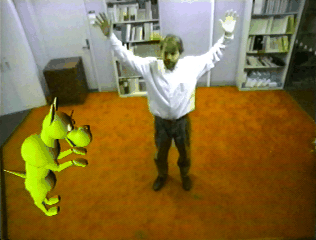
Figure 5.6:
Chris Wren playing with Bruce Blumberg's virtual dog in the ALIVE
space
The last of the gesture-language mappings is the most abstract. Again, it's related to the other gesture-languages discussed above, and the primary distinction lies in a subtle, but important, difference in the design of the interface. Best called ``gesture in context'' this mapping attempts to create an interface that is intuitive given the context. Ideally, the mapping is aligned so that failures in tracking or classification are transparent to the user. Clever mapping design can thus greatly reduce the need for sensor systems to perform flawlessly by playing off the expectations and socialization of the user. Because of that trait, this was the first system to be implemented in our lab (by Maes, Darrell, Blumberg, and Pentland[12]), in the form of the Artificial Life Interactive Virtual Environment (ALIVE).
ALIVE combines autonomous agents with an interactive space. The user experiences the agents (including hamster-like creatures, a puppet, and a well-mannered dog--Figure 5.6) through a ``magic-mirror'' idiom. The interactive space mirrors the real space on the other side of the projection display, and augments that reflected reality with the graphical representation of the agents and their world (including a water dish, partitions, and even a fire hydrant).